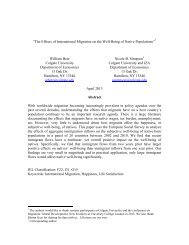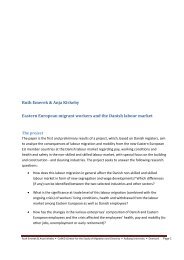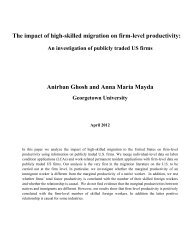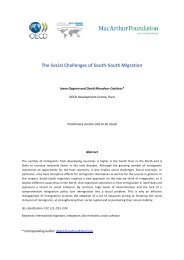The Role of Source- and Host-Country Characteristics in ... - CReAM
The Role of Source- and Host-Country Characteristics in ... - CReAM
The Role of Source- and Host-Country Characteristics in ... - CReAM
Create successful ePaper yourself
Turn your PDF publications into a flip-book with our unique Google optimized e-Paper software.
While estimates <strong>of</strong> models (2) <strong>and</strong> (3) provide <strong>in</strong>sights <strong>in</strong>to the role <strong>of</strong> a given set <strong>of</strong><br />
source- <strong>and</strong> host-country characteristics, respectively, <strong>in</strong> immigrant women’s labor supply,<br />
they do not acknowledge that the <strong>in</strong>terplay between both might also affect <strong>in</strong>dividual<br />
behavior. Specifically, one could argue that the higher the cultural difference, i.e., the<br />
higher the dissimilarity <strong>in</strong> the beliefs <strong>and</strong> attitudes regard<strong>in</strong>g work<strong>in</strong>g women between<br />
an immigrant’s source <strong>and</strong> host country, the more difficult it is to adapt to the labor<br />
market behavior <strong>of</strong> natives. In order to test this hypothesis, we estimate model (1) by<br />
now additionally <strong>in</strong>clud<strong>in</strong>g the difference <strong>in</strong> FLFP rates between the source <strong>and</strong> the host<br />
country – (F LF P R j − F LF P R k ) – which serves as our proxy for the cultural difference<br />
between the two countries:<br />
J<br />
lfp ijk = Φ(x ′ i β + ∑ K∑<br />
δ j c s j + γ k c h k + ρ(F LF P R j − F LF P R k ) + p ′ jk λ + t′ i ϑ + ɛ ijk). (4)<br />
j=2 k=2<br />
In order to consistently estimate the parameters <strong>of</strong> equations (1) to (4), we specify the<br />
probability that a certa<strong>in</strong> <strong>in</strong>dividual participates <strong>in</strong> the labor market by the use <strong>of</strong> a<br />
b<strong>in</strong>ary probit model, imply<strong>in</strong>g the assumption that ɛ ijk follows a normal distribution. 20 We<br />
estimate marg<strong>in</strong>al effects <strong>in</strong> all models. To address the problem <strong>of</strong> <strong>in</strong>traclass correlation <strong>in</strong><br />
st<strong>and</strong>ard errors <strong>of</strong> immigrants with<strong>in</strong> source- <strong>and</strong> host-country groups, respectively, we<br />
cluster st<strong>and</strong>ard errors at the source-country level (Model 2) <strong>and</strong> host-country level (Model<br />
3), respectively. 21 We further use host-country population weights <strong>in</strong> all regressions, which<br />
ensure that each country is represented <strong>in</strong> proportion to its actual population size.<br />
4 Basic Results<br />
<strong>The</strong> estimation results <strong>of</strong> Model (1) for first-generation (columns 2 <strong>and</strong> 3) <strong>and</strong> secondgeneration<br />
(columns 4 <strong>and</strong> 5) immigrants are shown <strong>in</strong> Table 1. <strong>The</strong> results for the<br />
<strong>in</strong>dividual <strong>and</strong> household controls are <strong>in</strong> l<strong>in</strong>e with previous evidence on female (immigrant)<br />
labor supply. For both first- <strong>and</strong> second-generation immigrants, labor force participation<br />
is significantly lower among older women (46 to 59) as compared to middle-aged women<br />
(36 to 45 years). A further strong predictor <strong>of</strong> the labor supply <strong>of</strong> immigrant women is<br />
their level <strong>of</strong> education, with those hav<strong>in</strong>g completed tertiary education be<strong>in</strong>g significantly<br />
more likely <strong>and</strong> those with only a primary school degree be<strong>in</strong>g significantly less likely<br />
to participate <strong>in</strong> the labor market than those with a secondary school degree. While<br />
20 Logit <strong>and</strong> l<strong>in</strong>ear probability models yielded similar results.<br />
21 While estimat<strong>in</strong>g clustered st<strong>and</strong>ard errors is the st<strong>and</strong>ard solution to address the problem <strong>of</strong> with<strong>in</strong>group<br />
error correlation, the st<strong>and</strong>ard errors obta<strong>in</strong>ed by this method might still be downward biased if the<br />
number <strong>of</strong> clusters is very small.(see,e.g., Angrist <strong>and</strong> Pischke, 2009) We therefore check the robustness <strong>of</strong><br />
our results by estimat<strong>in</strong>g a mixed effects logit model with crossed r<strong>and</strong>om effects (see Section ??).<br />
18







